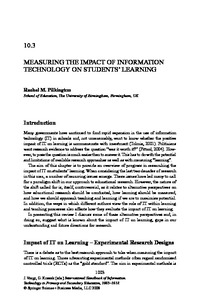Measuring the Impact of Information Technology on Students´ LearningRachel M. Pilkington
Zu finden in: International Handbook of Information Technology in Primary and Secondary Education (Seite 1003 bis 1018), 2009
|
 |
 Diese Seite wurde seit 2 Jahren inhaltlich nicht mehr aktualisiert.
Unter Umständen ist sie nicht mehr aktuell.
Diese Seite wurde seit 2 Jahren inhaltlich nicht mehr aktualisiert.
Unter Umständen ist sie nicht mehr aktuell.
 Zusammenfassungen
Zusammenfassungen
 Has the recent rapid expansion in the use of IT in schools had a positive impact on learning? Research has presented us with mixed results that are often difficult to interpret. Providing computers is certainly no guarantee of their effective use: how IT resources are used in the local context to meet individual students´ needs seems critical to success. In short, the alignment of particular types of IT to particular educational objectives and assessment methods, together with planned, structured and guided activity, are likely to determine whether IT impacts learning. However, this paper argues that the questions of how, when and why IT impacts learning will require more holistic approaches to data-gathering than traditional experimental or survey based approaches have provided. Further research adopting a range of methods is needed if we are to discover precisely how particular combinations of IT, instructional strategy and student activity lead to learning outcomes.
Has the recent rapid expansion in the use of IT in schools had a positive impact on learning? Research has presented us with mixed results that are often difficult to interpret. Providing computers is certainly no guarantee of their effective use: how IT resources are used in the local context to meet individual students´ needs seems critical to success. In short, the alignment of particular types of IT to particular educational objectives and assessment methods, together with planned, structured and guided activity, are likely to determine whether IT impacts learning. However, this paper argues that the questions of how, when and why IT impacts learning will require more holistic approaches to data-gathering than traditional experimental or survey based approaches have provided. Further research adopting a range of methods is needed if we are to discover precisely how particular combinations of IT, instructional strategy and student activity lead to learning outcomes. Dieses Kapitel erwähnt ...
Dieses Kapitel erwähnt ...
 Personen KB IB clear | B. S. Bloom | ||||||||||||||||||
 Texte |
|
 Zitationsgraph (Beta-Test mit vis.js)
Zitationsgraph (Beta-Test mit vis.js)
 Anderswo finden
Anderswo finden
 Volltext dieses Dokuments
Volltext dieses Dokuments
 |  Measuring the Impact of Information Technology on Students´ Learning: Artikel als Volltext bei Springerlink ( Measuring the Impact of Information Technology on Students´ Learning: Artikel als Volltext bei Springerlink ( : :  , 122 kByte; , 122 kByte;  : :  2020-11-28) 2020-11-28) |
 Anderswo suchen
Anderswo suchen 
 Beat und dieses Kapitel
Beat und dieses Kapitel
Beat hat Dieses Kapitel während seiner Zeit am Institut für Medien und Schule (IMS) ins Biblionetz aufgenommen. Beat besitzt kein physisches, aber ein digitales Exemplar. Eine digitale Version ist auf dem Internet verfügbar (s.o.). Aufgrund der wenigen Einträge im Biblionetz scheint er es nicht wirklich gelesen zu haben. Es gibt bisher auch nur wenige Objekte im Biblionetz, die dieses Werk zitieren.











 Biblionetz-History
Biblionetz-History